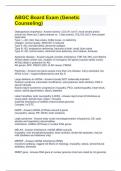ABGC Board Exam (Genetic
Counseling)
Osteogenesis imperfecta - Answer-Genes: COL1A1 (ch17; more severe pheno
w/mutn b/c there are 2 alpha strands vs. 1 beta strand), COL1A2 (ch7), form protein
triple helix
Type I -- AD, mild, blue sclera, brittle bones, no deformity
collagen: normal quality, AMOUNT is reduced
Type II: AD, neonatal lethal, abnormal collagen
Type III: AD, progressive deforming, fractures at birth, small, blue sclera
Type IV: AD, normal sclera, mild/mod bone deformity, short stature, fractures
Alzheimer disease - Answer-Usually complex inheritance, FDR risk 38% over lifetime
APOe4 allele confers risk, modifier of monogenic AD genes (causes earlier onset).
APOe2 allele is protective for AD.
AD genes: APP, PSEN1 (50% of AD cases), PSEN2
Pleiotropy - Answer-one gene causes more than one disease. many examples, but
APOe is one -- hypercholesterolemia and Alz D
Large deletions in mtDNA - Answer-Usually NOT maternally-inherited
Pearson syndrome: pancreatic insufficiency, pancytopenia, lactic acidosis, KSS in
second decade
Kearns-Sayre syndrome: progressive myopathy, PEO, cardiomyopathy, heart block,
ptosis, retinal pigmentation, ataxia, diabetes
Leber hereditary optic neuropathy (LHON) - Answer-rapid onset of blindness as
young adult, Gender bias: males > females
maternal inheritance of mtDNA (mitochondrial genome)
Complex I of ETC
NARP - Answer-mtDNA (ATPase subunit 6 gene)
neuropathy, ataxia, RP, DD/ID, lactic acidemia
Leigh syndrome - Answer-early onset neurodegeneration w/hypotonia, DD, optic
atrophy and respiratory abnormalities
Inheritance: mtDNA (ATPase) or nuclear DNA genes
MELAS - Answer-Inheritance: mtDNA (tRNA subunit)
myopathy, mito encephalomyopathy, lactic acidosis, stroke-like episodes, may be
mild (diabetes and deafness only)
MERRF - Answer-mtDNA inheritance (tRNA)
myoclonic epilepsy, ragged red fibers on histology, myopathy, ataxia, sensorineural
deafness, dementia
RMRP gene - Answer-RNA gene in nuclear genome (most are coded by mt genome)




